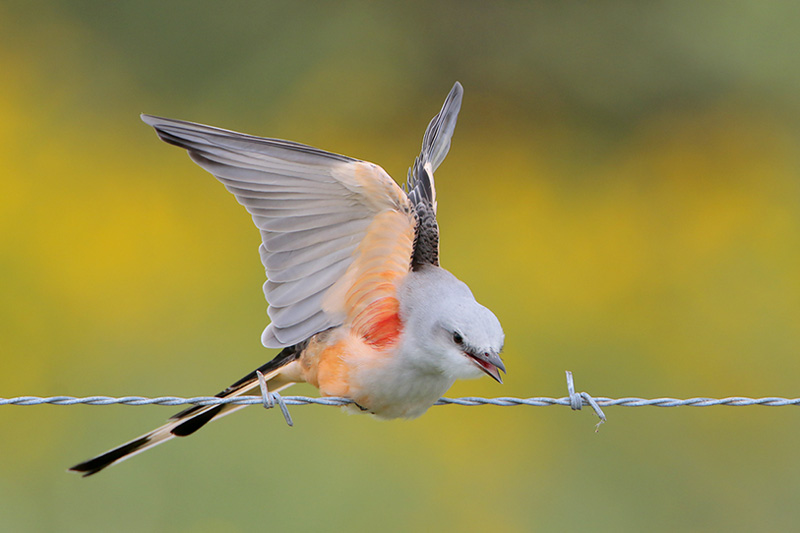
Oklahoma is a mid-sized state with 69,898 square miles of grasslands, woodlands, farms, and other habitats. It also has a population of 4,019,800. The Oklahoma state bird is the Scissor-tailed Flycatcher.
This elegant, long-tailed flycatcher is a summer bird of open fields, pastures, parks, and other open habitats in the state.
Scissor-tailed Flycatchers are pale, gray and white birds with black and white in their wings and an elongated forked tail. They also have salmon coloration on their flanks and under their wings, and chestnut highlights on their back.
In flight, the long tail of the Scissor-tailed Flycatcher streams out behind it and, from below, we can see that it has a black tip.
On this page
Oklahoma State Bird
The Scissor-tailed Flycatcher became the official Oklahoma state bird on May 26, 1951. The State Legislature chose this unique and striking species for a few different reasons. At first, when other states were choosing official state birds during the 1930s, the Northern Bobwhite was considered.
In 1932, the State Federation of Women’s Clubs sponsored a contest to choose the official state bird. Schoolchildren ended up voting for the Northern Bobwhite. However, the state legislature declined to vote and accept it as the official state bird. The whistled “bob-white!” call of this cute little quail is commonly heard in Oklahoma, and this factor may have influenced young people to vote for it.
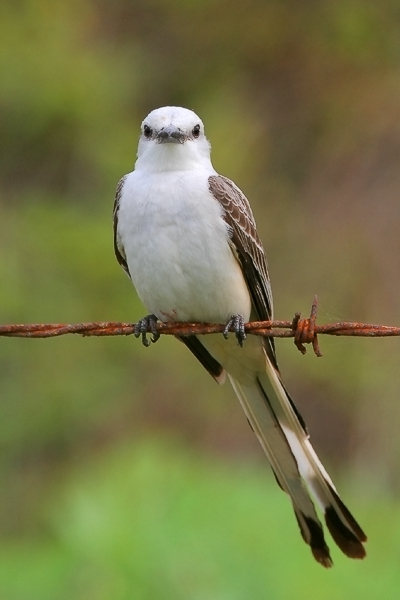
The Scissor-tailed Flycatcher became the official Oklahoma state bird on May 26, 1951. © Greg Lavaty.
After being promoted by the state’s Audubon Society and other organizations, the Scissor-tailed Flycatcher eventually won out as the state bird. An official vote was held after these groups convinced Lou Allard, the chairman of the House of Representatives Committee on Game and Fish, to support this species as the official state bird of Oklahoma.
It was chosen because no other state has the Scissor-tailed Flycatcher as a state bird, and, by eating grasshoppers and other insects, this species is beneficial to farmers.
The Scissor-tailed Flycatcher is also common in Oklahoma. In this state, we see these beautiful birds perched on posts and bushes, and watch the male’s fantastic “sky dance” display over open fields.
Fun Facts about Scissor-tailed Flycatchers
- A long tail for quick turns – This flycatcher uses its long, forked tail to help it make sharp turns and other quick maneuvers when catching insects in flight, and during its impressive aerial display.
- Scissor-tailed Flycatchers form impressive flocks – In late fall and winter, flocks of this species can number in the thousands. These flocks can form noisy roosts in large isolated trees.
- Nests include artificial materials too – This species often uses cigarette filters, pieces of cloth, and other things made by people when building its nest.
- Scissor-tailed Flycatcher can wander far from Oklahoma – This species has a tendency to migrate to places far north of where it usually occurs. Vagrants have appeared in places as far away as Nova Scotia, British Columbia, and the Hudson Bay.
- A hidden crown for this kingbird – Scissor-tailed Flycatchers are related to Eastern Kingbirds and other kingbird species. Like those birds, they also have a patch of colorful feathers on top of their head. However, they only reveal their red feathers when they are alarmed, or during courtship displays.
- The Texas Bird of Paradise – The Scissor-tailed Flycatcher is also known by this name on account of its long tail and being a common bird in Texas.
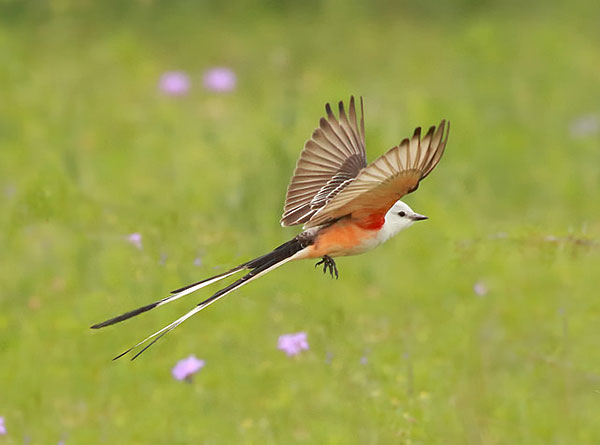
This flycatcher uses its long, forked tail to help it make sharp turns and other quick maneuvers when catching insects in flight, and during its impressive aerial display.
Identification
Scissor-tailed Flycatchers are slender, elegant birds with an extra-long, forked tail. They are 10 inches long, have a 15 inch wingspan, and weigh 1.5 ounces.
This eye-catching bird is easy to recognize. There aren’t any other birds in North America that have the pale colors and elongated tail of the Scissor-tailed Flycatcher. The only bird that comes close is the equally impressive Fork-tailed Flycatcher.
However, this rare vagrant migrant species from South America is dark gray and black above, white below, and doesn’t have as much white in its tail.
Adult Scissor-tailed Flycatchers are pale gray above, white below, and have salmon-pink on their flanks, belly, undertail, and under their wings. They also have long black wings with white edging, a black rump, and a long, black and white tail.
Both sexes look similar but females usually have pale orange instead of bright salmon pink, and have slightly shorter tails. Young birds are even paler, have much shorter forked tails, and pale yellow on their underparts.
In flight, its tail streams out behind it and the colors on the underwings become visible.
What do Scissor-tailed Flycatchers eat?
Scissor-tailed Flycatchers mostly feed on insects. They catch and eat a variety of insects, especially grasshoppers, beetles, and crickets. In addition, they also eat wasps, robber flies, and various other flying bugs.
This flycatcher species forages by waiting on a roadside post or other exposed perch next to grasslands and other open habitats.
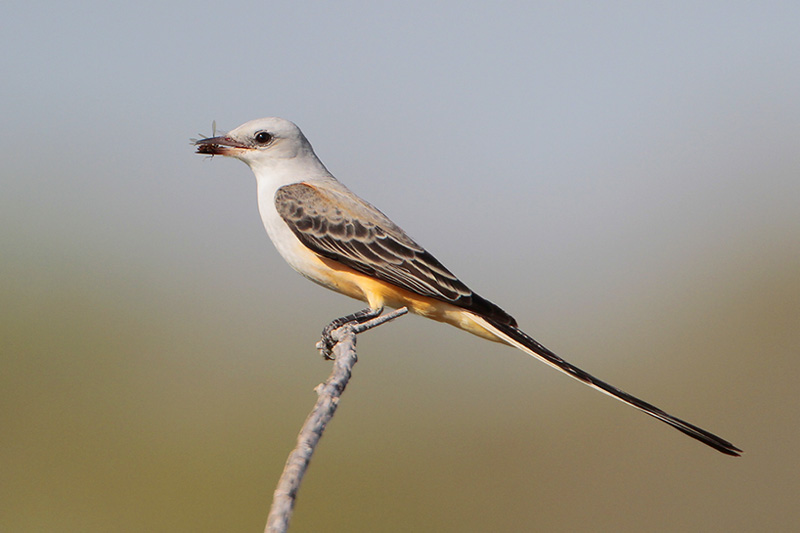
Scissor-tailed Flycatchers mostly feed on insects, especially grasshoppers, beetles, and crickets. © Greg Lavaty.
When it espies a tasty grasshopper sitting on a grass stalk, it quickly flies in and snatches it with its beak.
They can also fly to the ground to catch insects and, when the opportunity presents itself, fly into the air to catch insect prey in flight.
In fall and winter, Scissor-tailed Flycatchers also include fruit in their diet. Although they still perch on posts and bushes to feed on insects in open, grassy fields, flocks of this flycatcher also forage in tropical dry forest habitats.
Groups of this species and other birds visit fruiting trees and pick fruit while perched and in hovering flight.
Call
The Scissor-tailed Flycatcher often makes chattering “pik!” and “kopeck!” calls. It also sings a sputtering song that starts low before rising and becoming faster. This song is usually given from a prominent perch and sounds like, “pik..pik..pik.pik.pik,pik,pe-REEPAH!”
Behavior
Scissor-tailed Flycatchers are bold and easily seen birds that perch on roadside cables, posts, and other prominent places.
In spring, these long-tailed birds arrive on their breeding grounds to form pairs and nest. To find a mate, males sing and do an elaborate flight display.
Known as “sky dancing”, they fly 100 feet into the air and then fly back down while calling and opening and closing their tail as they make exaggerated zig-zag maneuvers.
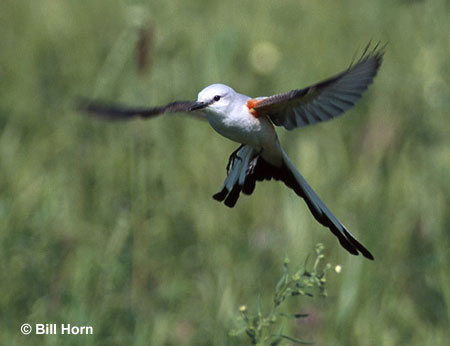
Known as “sky dancing”, they fly 100 feet into the air and then fly back down while calling and opening and closing their tail as they make exaggerated zig-zag maneuvers.
They build cup nests in bushes, trees, and under bridges and fiercely defend it against hawks and other potential threats.
By fall, Scissor-tailed Flycatchers form large flocks that mostly migrate to dry and open tropical habitats in southern Mexico and Central America.
This species is not aggressive with people but often dive bombs hawks and other animals that get too close to its nest. They could certainly also fly at pet cats and small dogs that enter their nesting territory.
FAQ of Oklahoma State Bird
What is the state bird of Oklahoma?
The Scissor-tailed Flycatcher is the state bird of Oklahoma.
What is Oklahoma state flower and animal?
The Oklahoma Rose is the state flower of Oklahoma. The Oklahoma state animal is the Bison.
What is unusual about the state bird of Oklahoma?
Scissor-tailed Flycatchers have one of the longest tails of any bird in North America.
Read next: Common Birds in Oklahoma | Owls In Oklahoma


Tonya M. Case
Wednesday 12th of July 2023
Would love to see photos (if taken) of nesting pair of orioles near Tulsa International Airport!
Patrick O'Donnell
Wednesday 12th of July 2023
@Tonya- We would love to see that too!